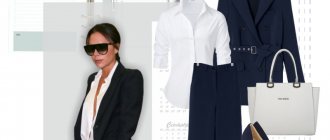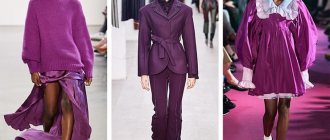A combination of luxury and simplicity
The concept of “purism” comes from the French word “purisme”, which means “striving for perfection”. In English and German, “pure” is translated as “precise, flawless, true.” The designation purism regarding architecture was first used by Le Corbusier in 1918. Later, this term began to be used when describing the style of furniture, and already in the second half of the 20th century, the expression was firmly entrenched in the vocabulary of interior designers. Purism appeared as an alternative to the rather boring ascetic, rational minimalism, “sterile” and cold high-tech. People wanted to “breathe life” into the interior, add luxury and sophistication, functionality and comfort. At the same time, it was important to preserve the atmosphere of lightness and simplicity of form. Purism, like a wealthy aristocrat, with all its generosity, hides money rather than displaying it. Behind the external restraint in such an environment are hidden expensive materials, exceptional quality decor, and designer items. This is a style for people with subtle innate taste and high social status. This “genre” has several distinctive features. One of them is the use of natural materials: wood, stone, leather, fur, etc. Plastic and metal are only possible in fragments in minimal quantities. Animal skins on the floor will fit the theme. A fireplace will also “fit” well into such an atmosphere. Marble or solid oak will look authentic on the floor. On the walls, brickwork and decorative plaster are equally possible. Complex ornaments and textured reliefs are not the strong point of purism. You will not find intricate figurines here. Paintings are rarely used. Purity of lines and forms is another characteristic feature of purism. All furnishings should be functional, practical and comfortable. As for colors, purist interiors use deep, clean, natural colors. If you remember that you have seen some colors in nature. use them. Bright, flashy, “acid” shades are prohibited in such an interior. A puristic interior does not get bogged down in details, but requires close attention to these very little things. The decor here must be carefully thought out. If you suffer from “souvenir mania” or your friends love “memento” gifts, then the work of a professional designer on your home will quickly “come to naught” and the house will turn into an example of eclecticism. This direction allows and even welcomes the use of innovation. When choosing technical “stuffing” for your home, delve into the latest inventions of the world's leading brands. Purism, in contrast to minimalism, which was intended as a design option for small apartments, is also suitable for spacious rooms. It is better to entrust interior design in the purist style to professionals. In Ukraine there are few studios working in this direction. And this is good. Because, in this way, one can say that “natural selection” has occurred in the market. Existing bureaus can safely be called pioneers, looking to the future, keeping their finger on the pulse of interior fashion. Companies that are unsure of their abilities will not set out to “tread down” the path, but will go along the already thoroughly laid “asphalted” road. If you dare to independently arrange your own purist space, have a good understanding of the style. Please note that there are many subtleties and nuances in this direction. This is not baroque, where excess is good. In a purist atmosphere, the most important thing is to maintain a balance: not to overdo it and not to be greedy. Because a step to the left is already minimalism, and a step to the right is avant-garde.
Design studio Ruslan Kovalchuk
The main features of purism: · Eco-friendly materials · Natural colors · Functionality · Purity and simplicity of lines and shapes
The paparazzi continue to pursue Angelina Jolie, speculating on the topic of her thinness and mental state, but the actress tries not to pay attention to them and continues to go about her usual business. She does this in a very beautiful and elegant way. So, the last pictures of Jolie were taken during her Sunday walk with her son Madox, and she was dressed like a true lady of the 1950s - a beige total look consisting of a bustier dress and a cashmere stole, large glasses with metal frames and Celine bags with a rigid shape and short handles.
This image is an ideal illustration of the actress’s new style, which Western journalists call the phrase luxe purism. It is based on discreet and discreet clothing without unnecessary details. Purism is distinguished by aesthetic clarity, emphasized simplicity and functionality, but it is this style that makes the greatest demands on the quality of things. The fabrics here must be of the best quality and the fit perfect. The slightest flaws will be visible instantly.
These are the images that Angelina Jolie has been increasingly choosing lately. While critics believed that she was going through a difficult divorce and therefore began to dress boringly, fashion insiders saw the actress’s gray, black, beige and white looks as the best example of modern purism or luxe purism. Her wardrobe is now beyond seasonal trends, and all the things in it are easily combined with each other.
Purism became popular in the 1980s. His main fans then were young career women. They needed high-quality and understandable clothing that would not distract them from building a successful career. 30 years ago, this movement was led by the Italian Giorgio Armani with his trouser suits and exemplary dark blue shade, as well as the German Gilles Sander. Jolie, who raises six children alone, makes films and does charity work as a UN Goodwill Ambassador, also doesn't have time to change clothes several times a day, but doesn't want to be seen in a stretched T-shirt and old jeans. Purism helps her look appropriate wherever she goes.
Many girls who have no time to think about combining fashionable prints and experimenting with layering can adopt this style. Moreover, Angelina’s principle “Look simple, but expensive” is not always a matter of price. Her wardrobe includes both Max Mara camel coats and Uniqlo cashmere sweaters for a couple of tens of euros. And together they give working combinations for every day.
One of the main components of Angelina Jolie's wardrobe is skirts. She wears both classic pencils and slightly flared models. Most often, the actress combines silk blouses and nude pumps with them, which will be appropriate with absolutely any wardrobe.
In addition, purism is a way out for those who think about the ethical component and seek to reduce their consumption of clothing, because the fashion industry is the second largest pollutant of the environment.
What's great about classics is their timeless position in relation to other styles. New trends in the fashion world come, turn women’s heads, and soon go away, making way for the next trends and tendencies. Whether it’s the classic style of clothing - unlike its counterparts, it is so firmly entrenched in the fashion Olympus that no new trends can shake it.
Story
It is difficult to say exactly when the classical style of clothing was born, since it seems to exist outside the framework of a time and geographical paradigm. However, it can be said that its formation was largely influenced by British fashion, starting in the 17th century. The Puritan style, with its severity and minimalism, laid the foundations of the modern classical style. The emergence of the feminist movement also had an impact on the formation of the canons of classic fashion, because initially classical suits were worn exclusively by men. Such masters as Cristobal Balenciaga and Coco Chanel made their contribution to the formation of the postulates of classic style. The role of the latter is especially great: Mademoiselle Coco managed to become the queen of women's classics, and not a single female fashion designer has yet been able to challenge this title.
Despite the fact that the foundations of classical fashion are monolithic and unshakable, like granite, over time, some details still change. Fashion trends and new trends make their way into the realm of classics, preventing them from becoming ossified and outdated.
The history and significance of the classic clothing style
One of the most basic and time-tested is the classic clothing style, relevant at all times and in all situations. It is suitable for women of all ages, body types, financial capabilities and skills in creating their own image. Why? Yes, because the classic style of clothing, translated from Latin, means “belonging to the highest rank, exemplary and first-class.”
The progenitor of this style is considered to be the strict English men's suit, transformed by fashion designers from gray and dull attire for respectable gentlemen into something lively, varied and incredibly elegant. Exactly what we now call women's classic style, with some strict elements borrowed from the men's suit.
The origins of the women's classic style were such a great female fashion designer as Coco Chanel . She brought into fashion women's trouser suits, straight skirts below the knee, complete with blouses or jackets. For a more feminine twist on classic style, Coco created her signature little black dress, suitable for any occasion and on any woman.
It was this invention of the great Coco that gave women confidence that classic-style dresses, strict and elegant, could come to the rescue in any situation.
Well, the most famous followers of the classic style were Audrey Hepburn and Margaret Thatcher, who embodied femininity, elegance, strength and the desire for success in their images. In many ways, it was the women's classic style of clothing that helped them.
More on the topic: Fashion trends spring-summer 2011
Classic clothing style: what is it based on?
The classical style has come a long way, during which it has managed to become truly exemplary (by the way, the word “classic” comes from the Latin “classicus,” which is precisely translated as “exemplary”). It is based on the following principles:
- elegance;
- harmony;
- proportionality;
- restraint;
- self-esteem;
- lack of trendy details, silhouettes, colors;
- functionality;
- knowing of limits;
- severity;
- femininity.
Classic style is often mixed with business style. These two directions do have common features, but they are not identical concepts. The business style simply inherited the features of the classic style, as it is associated with success, good manners, impeccable manners and similar taste. Proof of this is the immortal images in which the world remembers Coco Chanel, Audrey Hepburn, Grace Kelly, Jacqueline Kennedy, Margaret Thatcher.
Modeling a wardrobe in classical traditions
Dress
When choosing a dress style for herself, a woman, first of all, must be clearly aware of the purposes for which this outfit will serve and what emotion it will convey. Don’t forget to carefully select an outfit to suit your body type. After all, a classic dress is specific in its simplicity and will not always be appropriate. Taking into account all these parameters and features, we can conclude that choosing a Puritan dress is a rather labor-intensive process. Modesty is the highlight, that’s the main slogan of this outfit.
- The color scheme is very restrained tones, but not mournful, no bright shades, not to mention prints or bold play with color;
- Absence of draperies and combinations of different fabric textures, inadmissibility of the use of sequins, beads, and other effects;
- Using exclusively high-quality material, no synthetics, only natural, traditional fabrics combined with high sewing techniques and laconic cut;
- The style of the dress presupposes strict lines; a minimal deviation from the body silhouette is allowed.
The length is regulated by the time of day.
In the morning, midi length predominates; for lunchtime, it is better to prefer a pastel-colored dress of medium length; you can place a slight emphasis on the waist with a thin belt. A dress for a work environment or business meetings requires the use of stockings and the most laconic form. The best example of how you can combine and create a Puritan wardrobe can be English magazines, which present a classic style of clothing for women. Here you can clearly see that simplicity is also elegance. Evening dresses are distinguished by impeccable cut, presentability and obvious solidity of the outfit. Oddly enough, a deep neckline is acceptable here, and a sexy neckline that exposes the back is not contraindicated; a cut that charmingly reveals a graceful leg is not contraindicated. Here it is in all its splendor - classic style. Women's clothing of this type will give a head start to nondescript T-shirts and jeans.
Costume
When it comes to creating a classic look with a suit, tweed models made in the best English traditions involuntarily come to mind. It is worth mentioning some features of choosing a classic suit:
- Firstly, the jacket and skirt should have a simple cut and be made in the same design solution. The skirt is either knee-length or ankle-length, with a small slit on the side or back. The jacket should be length to the upper third or mid-thighs. The color of the buttons should match the tone of the suit material;
- Secondly, the blouse should be several tones lighter than the suit itself. If this condition is not met, then you should limit yourself to a blouse that is identical in tone to the suit, but different in texture. It is permissible to complete the look with an elegant silk scarf;
- Thirdly, it is acceptable to replace a classic skirt with trousers. If you choose this option, then the most successful combination would be a dark bottom and a light top. Depending on your body type, choose the style of trousers: tube trousers will look more trendy;
- Fourthly, the combination of a classic jacket and a formal blouse with casual jeans would be simply blasphemous. This combination is unacceptable due to the excessive versatility of jeans: they simply do not fit into the sophistication and presentability of a classic cut.
Dear ladies, you can look sophisticated and elegant in simple outfits, the classic look is a clear confirmation of this. Allow yourself sometimes the luxury of being “simple”, and in this simplicity you will find charm. The legendary fashion trendsetter Coco Chanel once said: “It is impossible to be innovative all the time. I want to create classics!”
Main components
- The dress
is the foundation of the classic style in women's clothing. It can be very different - it all depends on the purpose, the figure of its owner and the purposes that the dress is intended to serve. The best option is a sheath dress that is knee-length or slightly lower. It is advisable that the color be restrained - black, blue, white, any of the pastel shades. Of the prints, only unobtrusive and discreet patterns are allowed - checks, thin stripes, small polka dots, chicken foot, herringbone. As for the length, it is dictated by the time of day and the purpose of the dress. So, for the first half of the day, a midi dress is suitable, while for an evening social event - a maxi-length model (unlike the daytime version, an evening dress made in a classic manner even includes slits and a neckline).
- Suit with trousers or skirt
. Simplicity rules the roost here. Both the lower part of the suit and the jacket should be made quite minimalistically, have a strict cut and fit perfectly. Pay attention to the material - tweed, thin wool, jersey are best suited for a classic suit, and in the summer version - linen.
- Blouse
. It can be moderately strict, moderately feminine, both tight-fitting and spacious (in this case, the blouse should be made of light materials such as chiffon or silk). The color of the blouse should be restrained and non-flashy.
- Shoes
. It may have a heel, but it should not be too high - up to 6-7 cm. Pumps, neat boots or ankle boots, without an abundance of flashy decor - this is what is useful for creating an image in a classic style. - Accessories
. There shouldn't be many of them. It is advisable that the jewelry be discreet, modest and not cheap. A string of pearls, a thin watch, an elegant strap, a silk scarf - all this can decorate its owner, who dresses a la classic.
Main features and characteristics of clothing in a classic style
The main motive in women's classic clothing style is the complete absence of overt eroticism. Here you will almost never see high slits on skirts, deep necklines or overly tight styles. And the color scheme is not replete with all the colors and shades available for a modern designer’s flight of fancy. Everything is orderly and strict.
But not boring, but decent and restrained, as well as elegant and sexy.
Since its foundation, the classic style of clothing has been an indicator of the dignity of its owner, his respectability, restraint, intelligence, rationality, harmony, nobility and professionalism. It is not without reason that business style clothing is derived from the classical style.
All elements of clothing should be perfectly combined with each other and complement the ensemble. Skirts, jackets, dresses, blouses and trousers should all be grouped in a perfect manner according to current fashion trends.
As for accessories and jewelry, they are acceptable, but only in very limited quantities. Each element must be justified and clearly verified, because it is very easy to destroy the image of a sophisticated lady, especially with the help of a bright and bulky accessory, the place of which is not on a strict and elegant suit, but on the New Year tree.
The same applies to the color scheme of the chosen clothes . The classic clothing style does not accept bright colors and sharp color contrasts. The main shades of the style are black, brown, beige, all shades of gray, blue, and even caramel tones. Available patterns include stripe, herringbone, checkered and houndstooth. No polka dots, flowers, bunnies or cat faces, this is not respectable.
Shoes in the classic style exclude high heels, rough platforms and wedges, thick heels and bright, catchy elements. The best option would be pumps to match the suit with low elegant heels or without them, making the foot beautiful and light.
More on the topic: Evening style in fashion
But handbags d are worn in a more free and frivolous way, the main thing is that they are in harmony with the ensemble and are not decorated with unnecessary and pretentious elements that catch the eye. The size and shape of bags can be different, but the main thing is not to ruin the entire image of a stylish lady.
History of style and different interpretations of classics in the interior
Classic style has perhaps the largest number of definitions; do not be surprised if you come across completely different interpretations of this term. It is also worth noting that all these interpretations are very closely intertwined. So, let's try to list the main definitions that we understand by classics today.
- Classic is antiquity and everything connected with it. Perhaps no culture has given the modern world so many standards and rules as ancient Greece and Rome. The classicism style, which appeared at the end of the 18th century, became a direct continuation of ancient traditions, so it can also be attributed to this group.
- Classics are the historical styles of Europe that appeared in the period from the 17th to the 19th centuries. This group includes: Baroque, Rococo, Classicism, Empire.
- National styles of European countries are also classics. You can often come across such concepts as English classics or, say, French. It is important to know that the styles listed in paragraph 2 also have their own national characteristics (for example: Russian Baroque).
- Classic is a modern interior created on the basis of generally accepted rules and canons. Such interiors are distinguished by strict symmetry, neutral colors, and the most simple and logical delimitation of space.
If you tell your designer that you want to make the interior of your apartment in a classic style, then it is best to explain what exactly you mean by such a style, otherwise misunderstanding may arise.
Decor elements
There are a huge number of techniques for decorating an interior in a classic style. Here are the most common decorating methods.
- a large amount of textiles: curtains, bedspreads, decorative pillows with embroidered patterns;
- wall and ceiling moldings;
- paintings in a realistic style or engravings in luxurious frames;
- artistic paintings, frescoes;
- expensive accessories: watches, candlesticks, figurines, vases;
- additional lighting fixtures: wall sconces with characteristic shades.











